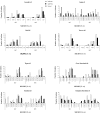Essential Oils, Silver Nanoparticles and Propolis as Alternative Agents Against Fluconazole Resistant Candida albicans, Candida glabrata and Candida krusei Clinical Isolates
- PMID: 25805904
- PMCID: PMC4363251
- DOI: 10.1007/s12088-014-0508-2
Essential Oils, Silver Nanoparticles and Propolis as Alternative Agents Against Fluconazole Resistant Candida albicans, Candida glabrata and Candida krusei Clinical Isolates
Abstract
Development of effective and safe therapeutic treatment of fungal infections remains one of the major challenge for modern medicine. The aim of presented investigation was to analyze the in vitro antifungal activity of selected essential oils, ethanolic extracts of propolis and silver nanoparticles dropped on TiO2 against azole-resistant C. albicans (n = 20), C. glabrata (n = 14) and C. krusei (n = 10) clinical isolates. Among tested essential oils, the highest activity has definitely been found in the case of the oil isolated from the bark of Cinnamomum cassia, with MIC and MFC values for all tested strains in the range of 0.0006-0.0097 % (v/v) and 0.0012-0.019 % (v/v), respectively. High activity was also observed for the Lemon, Basil, Thyme, Geranium and Clove (from buds) essential oils. Significant differences in fungicidal activity have been observed in the case of four tested propolis samples. Only one of them revealed high activity, with MFC values in the range from 0.156 to 1.25 % (v/v). Satisfactory fungicidal activity, against C. albicans and C. glabrata isolates, was also observed in the case of silver nanoparticles, however C. krusei isolates were mostly resistant. We also revealed that constituents of most of essential oils and propolis as well as silver nanoparticles are not substrates for drug transporters, which belong to the most important factors affecting resistance of Candida spp. clinical isolates to many of conventional antimycotics. To conclude, the results of our investigation revealed that essential oils, propolis and silver nanoparticles represent high potential for controlling and prevention candidiasis.
Keywords: Candida albicans; Candida glabrata; Candida krusei; Essential oils; Propolis; Silver nanoparticles.
Figures




Similar articles
-
Liquid and vapour-phase antifungal activities of essential oils against Candida albicans and non-albicans Candida.BMC Complement Altern Med. 2016 Aug 30;16(1):330. doi: 10.1186/s12906-016-1316-5. BMC Complement Altern Med. 2016. PMID: 27576581 Free PMC article.
-
In vitro activity of essential oils extracted from plants used as spices against fluconazole-resistant and fluconazole-susceptible Candida spp.Can J Microbiol. 2008 Nov;54(11):950-6. doi: 10.1139/w08-097. Can J Microbiol. 2008. PMID: 18997851
-
In vitro activity of essential oils extracted from condiments against fluconazole-resistant and -sensitive Candida glabrata.J Mycol Med. 2015 Sep;25(3):213-7. doi: 10.1016/j.mycmed.2015.06.003. Epub 2015 Aug 14. J Mycol Med. 2015. PMID: 26281965
-
Candida and candidaemia. Susceptibility and epidemiology.Dan Med J. 2013 Nov;60(11):B4698. Dan Med J. 2013. PMID: 24192246 Review.
-
Resistance in human pathogenic yeasts and filamentous fungi: prevalence, underlying molecular mechanisms and link to the use of antifungals in humans and the environment.Dan Med J. 2016 Oct;63(10):B5288. Dan Med J. 2016. PMID: 27697142 Review.
Cited by
-
Antimicrobial and synergistic effects of lemongrass and geranium essential oils against Streptococcus mutans, Staphylococcus aureus, and Candida spp.World J Crit Care Med. 2024 Sep 9;13(3):92531. doi: 10.5492/wjccm.v13.i3.92531. eCollection 2024 Sep 9. World J Crit Care Med. 2024. PMID: 39253314 Free PMC article.
-
Clinical applications of antimicrobial photodynamic therapy in dentistry.Front Microbiol. 2023 Jan 5;13:1020995. doi: 10.3389/fmicb.2022.1020995. eCollection 2022. Front Microbiol. 2023. PMID: 36687594 Free PMC article. Review.
-
Small extracellular vesicles convey the stress-induced adaptive responses of melanoma cells.Sci Rep. 2019 Oct 25;9(1):15329. doi: 10.1038/s41598-019-51778-6. Sci Rep. 2019. PMID: 31653931 Free PMC article.
-
Propolis: A Complex Natural Product with a Plethora of Biological Activities That Can Be Explored for Drug Development.Evid Based Complement Alternat Med. 2015;2015:206439. doi: 10.1155/2015/206439. Epub 2015 May 27. Evid Based Complement Alternat Med. 2015. PMID: 26106433 Free PMC article. Review.
-
Antifungal and anti-biofilm activity of a new Spanish extract of propolis against Candida glabrata.BMC Complement Med Ther. 2021 May 21;21(1):147. doi: 10.1186/s12906-021-03323-0. BMC Complement Med Ther. 2021. PMID: 34020643 Free PMC article.
References
-
- Calderone RA. Introduction and historical perspectives. Candida and Candidiasis. Washington, DC: ASM Press; 2002. pp. 15–25.
LinkOut - more resources
Full Text Sources
Other Literature Sources
Miscellaneous
